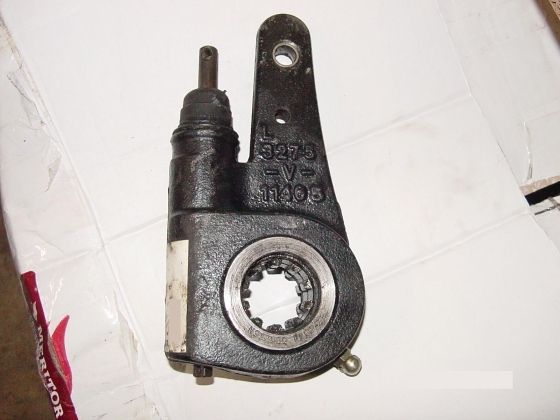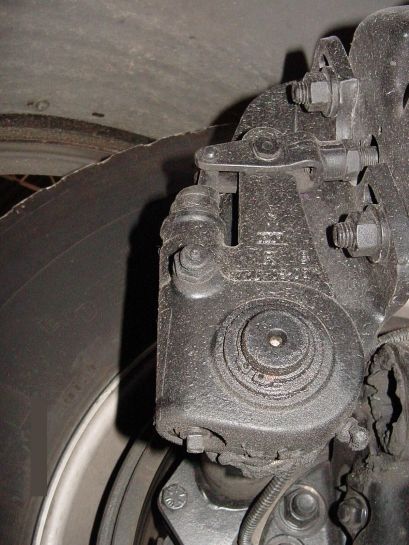National Institute for Occupational Safety and Health

Photo NIOSH
An automatic slack adjuster is seen in this handout photo.

Photo NIOSH
The automatic slack adjuster is seen as a component of the foundation brakes.
NIOSH recommends that all fire departments operating fire apparatus equipped with automatic slack adjusters (ASAs) immediately take the following actions to reduce the risk of fire fighters being injured in an apparatus crash due to brake failure:
• Ensure that ASAs are not manually adjusted.
• Establish procedures to ensure maintenance on fire apparatus is conducted as recommended in NFPA 1911 Standard for the Inspection, Maintenance, Testing, and Retirement of In-Service Automotive Fire Apparatus.
• Ensure maintenance is only performed by qualified technicians who meet NFPA 1071 Standard for Emergency Vehicle Technician Professional Qualifications.
An automatic slack adjuster is a mechanical component of the air brake system that adjust brakes as necessary when the vehicle is in operation to compensate for wear in the brake shoes (drum brakes) or pads (disc brakes). When an ASA is found to be out of adjustment, it signifies the existence of a larger braking system problem that needs correction. Manual adjustment of ASAs should only be done by qualified technicians during installation or when absolutely necessary to move the apparatus to a repair facility (NTSB 2006, 2007; IAFC 2006).
In 2006, the International Association of Fire Chiefs (IAFC) warned the fire service of this potential problem (IAFC 2006) following an investigative report released by the National Transportation Safety Board (NTSB 2006). While conducting an investigation of a recent apparatus crash-related fire fighter fatality, NIOSH learned that fire departments may not fully appreciate the hazards related to manual adjustment of ASAs. NIOSH would like to renew efforts to bring this to the attention of all U.S. fire departments, fire fighters, and fleet maintenance departments who are tasked with preventive maintenance or operation of apparatus equipped with ASAs. The manual adjustment of ASAs may contribute to unexpected brake failure on fire apparatus. When an ASA is found to be out of adjustment it signifies the existence of a larger problem with the braking system that needs to be corrected immediately. Vehicles found to have ASAs that are out of adjustment should be taken out-of-service immediately until corrective brake service is completed.
Fire Departments should ensure that all technicians conducting brake service on fire department apparatus: (1) are certified in air brake repair to the level (T-4) required by the Automotive Service Excellence Medium/Heavy Duty Truck Technician Certification and (2) have, at a minimum, Level 1 Fire Apparatus Technician Certification as certified by the Emergency Vehicle Technician Certification Commission. Additionally, fire departments should adhere to manufacturer guidelines and recommendations and applicable federal, state or provincial, and local laws regarding apparatus inspection and maintenance [NFPA1911].
Further, the NTSB has recommended, and NIOSH agrees, that all drivers of fire apparatus equipped with air brakes must undergo training and testing to demonstrate proficiency in the inspection and operation of air-braked vehicles. Such training should emphasize that manual adjustment of automatic slack adjusters is dangerous and should not be done, except during installation, or in an emergency situation when it is absolutely necessary to move the vehicle to a repair facility.
References
IAFC [2006]. Lessons learned from a fatal crash: Truck air brake warning: Manually adjusting automatic slack adjusters is dangerous, can lead to deadly consequences. Fairfax, VA: International Association of Fire Chiefs, Article on Website. Date accessed: September 2009. http://www.iafc.org/displayindustryarticle.cfm?articlenbr=30820.
NFPA [2006]. NFPA 1071 Standard for emergency vehicle technician professional qualifications. 2006 ed. Quincy, MA: National Fire Protection Association.
NFPA [2007]. NFPA 1911 Standard for the inspection, maintenance, testing, and retirement of in-service automotive fire apparatus. 2007 ed. Quincy, MA: National Fire Protection Association.
NTSB [2006]. Collision between a Ford dump truck and four passenger cars, Glen Rock, PA, April 11, 2003. Washington, DC: National Transportation Safety Board, NTSB Report Number HAR-06/01.
NTSB [2007]. Facts on truck brake maintenance: Dangers of manually adjusting slack adjusters. Washington, DC: National Transportation Safety Board, August.










